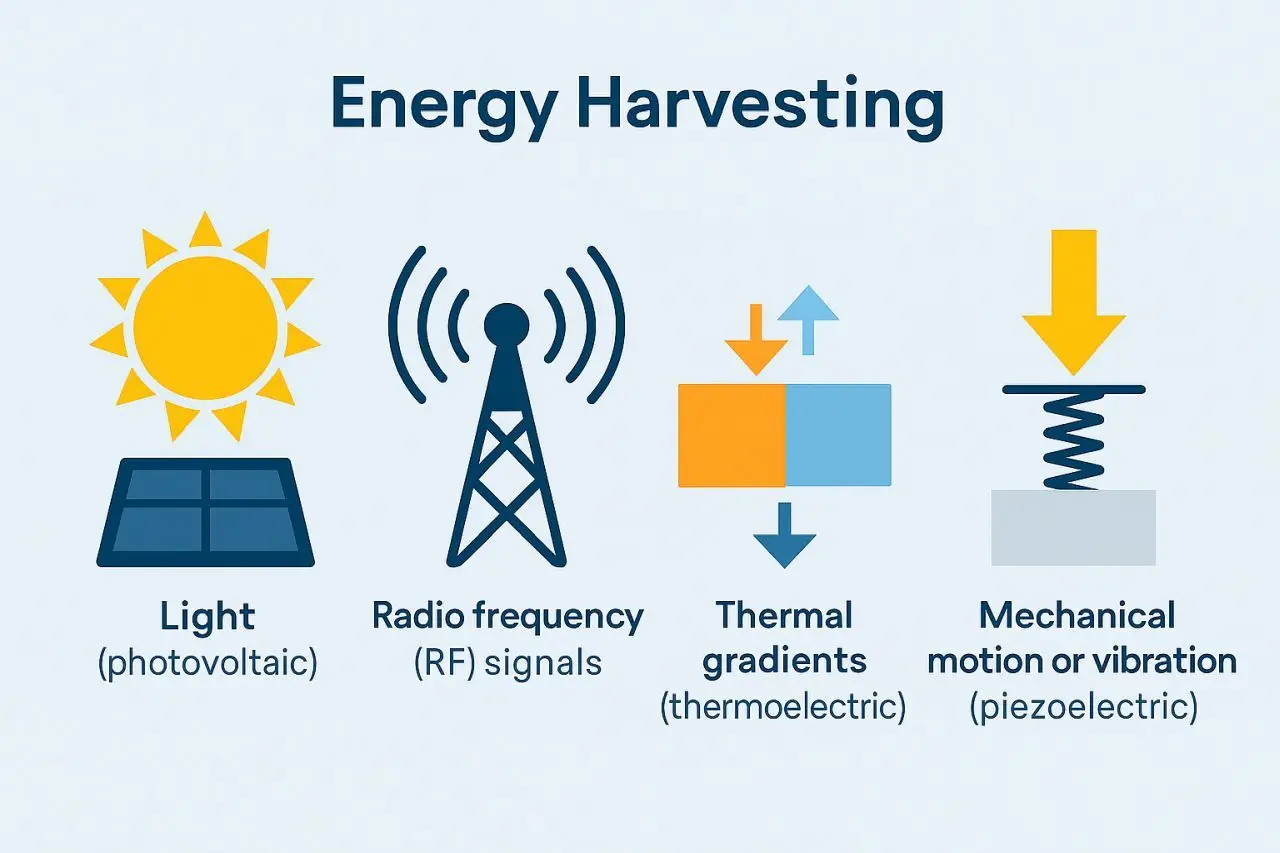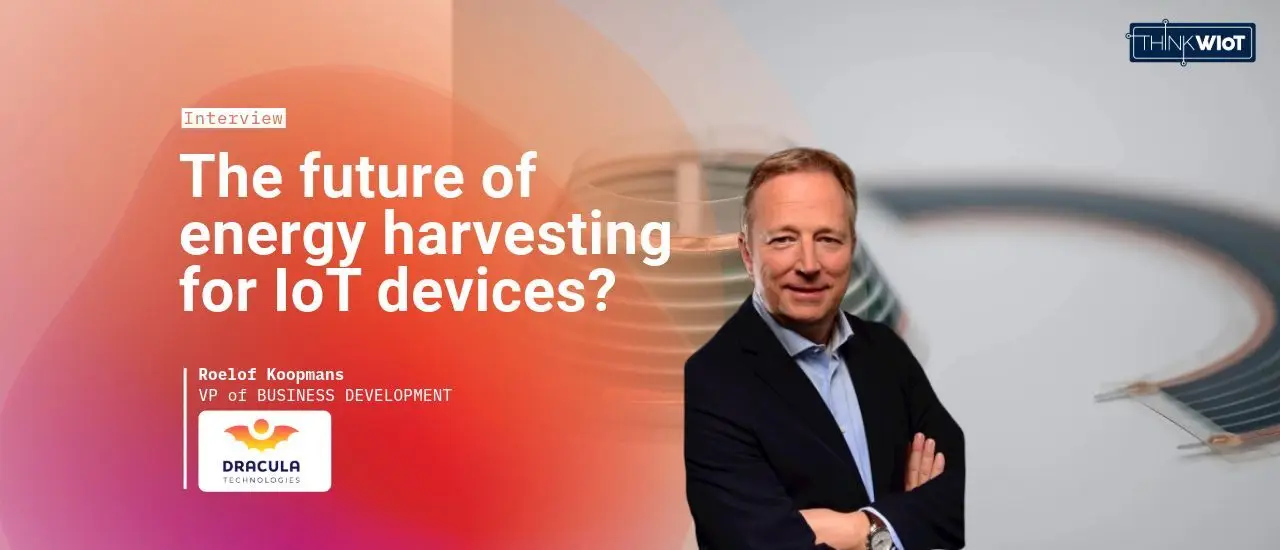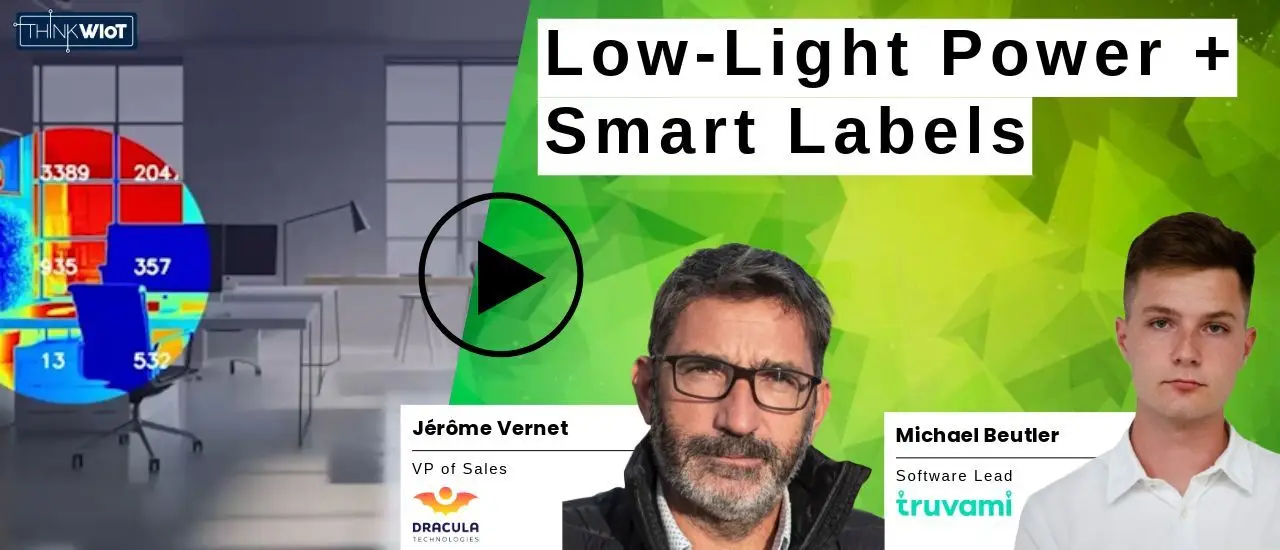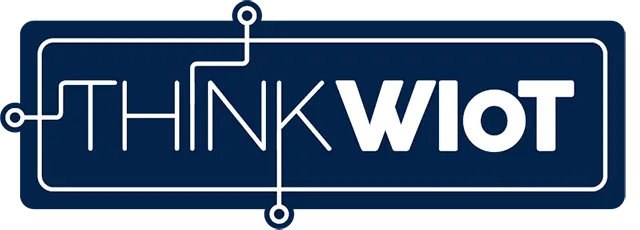Energy Harvesting - Powering the IoT Sustainably
Ambient energy harvesting is a viable, scalable approach to power IoT devices sustainably, reducing reliance on disposable batteries and enabling long-term, maintenance-free deployments.
- Published: June 16, 2025
- By: Anja Van Bocxlaer
- Read: 7 min
- Ambient energy sources—light, RF, thermal gradients, and motion—can sustainably power many ultra-low-power IoT devices.
- Photovoltaic (including OPV) is the most mature method for indoor and outdoor light harvesting, especially for smart labels and sensors.
- RF harvesting enables operation in dark or enclosed environments using rectennas and works well for intermittent, low-duty transmissions.
- Challenges include limited power density, compact energy storage needs, higher upfront system costs, and the need for standardization.

Energy Harvesting Today
The demand for energy-autonomous IoT devices is growing fast. With billions of sensors in use, batteries and wired power are reaching their limits in terms of maintenance, cost, and environmental impact. Most batteries are unsustainable due to limited lifespan, toxic materials, and recycling challenges. However, there are promising developments in eco-friendly battery technologies.
One such example is Zinergy, a leading manufacturer of printed, flexible, lithium-free batteries designed for smart labels, wearables, and tags. Zinergy’s batteries are safe, lightweight, and can be disposed of in regular household waste. They are robust enough to be cut, punctured, or torn without risk of combustion and are free from regulatory constraints for transport. These batteries support wireless technologies like RFID, Bluetooth™, Sigfox, LoRa, LTE, and power a wide range of environmental sensors, including for temperature, humidity, movement, and light.
Still, even with such advances, the industry is increasingly looking toward energy harvesting as a maintenance-free and sustainable alternative, especially in use cases where battery replacement is impractical.
Key to this shift is the dramatic drop in power consumption of sensors and microcontrollers. Many now operate in the microwatt range, enabling ambient energy sources—such as light or RF signals—to deliver enough power for sensing, processing, and wireless communication, particularly when paired with storage elements like supercapacitors or thin-film batteries.
Anja Van Bocxlaer - Managing Director, Think WIoT
Today, the most promising ambient energy sources include:
Light (photovoltaic)
Radio frequency (RF) signals
Thermal gradients (thermoelectric)
Mechanical motion or vibration (piezoelectric)
Each source has unique advantages depending on the environment and use case. Below, we focus on the two most actively advancing and broadly deployable methods: photovoltaic and RF energy harvesting.
Photovoltaic Energy Harvesting
Photovoltaic (PV) energy harvesting is the most mature form of ambient energy conversion. It involves capturing light—either natural sunlight or artificial indoor light—and converting it into electricity using photovoltaic materials.
While traditional silicon-based solar cells are effective under direct sunlight, they perform poorly in indoor or shaded conditions. This is where organic photovoltaic (OPV) technologies shine. These flexible, printed cells are tuned for low-light environments and can generate energy from LED, fluorescent, or diffuse ambient light. They are thin, lightweight, and can be printed on various substrates, allowing integration into labels, packaging, or curved surfaces.
In the context of IoT, indoor PV energy harvesting is already powering smart labels, sensors, switches, and data loggers—especially in places like warehouses, retail shelves, offices, or hospitals where light is always available but mains power is not.
RF Energy Harvesting
Radio frequency (RF) energy harvesting extracts power from electromagnetic waves emitted by existing sources such as Wi-Fi routers, Bluetooth devices, mobile phones, or even RFID readers. Although the energy density of RF is generally lower than that of light, RF harvesting has several important advantages:
Operates in complete darkness, where PV harvesting is not feasible
Can function in fully enclosed spaces, such as packaging, containers, or underground
Supports use cases where a dense RF environment (e.g., logistics hubs) ensures sufficient signal strength
RF harvesting modules often rely on rectennas (antenna + rectifier) to convert AC RF signals into DC voltage. These systems work well in conjunction with ultra-low-power chips and efficient energy management ICs. While still less efficient than light harvesting, RF harvesting is particularly suitable for passive devices that only need occasional bursts of energy to transmit data or wake from sleep mode.
Real-World Applications Where Energy Harvesting Delivers Value
The number of real-world applications of energy harvesting is growing rapidly, especially in Industrial IoT, smart buildings, logistics, agriculture, and medical devices.
1. Industrial Monitoring
In factories or infrastructure systems, wireless sensors powered by vibration or thermal energy can monitor machine health, temperature, or structural strain—without the need for rewiring or battery replacement. These systems are ideal for predictive maintenance and asset management.
2. Smart Homes & Buildings
Energy harvesting switches and sensors, particularly using EnOcean technology, have become common in building automation. These components draw power from motion (e.g., pressing a light switch) or indoor light, enabling battery-free smart lighting, HVAC control, and occupancy detection.
Read also:
The Future of Buildings: Light-Powered Sensors With No Battery Changes! (Install Once, Zero Maintenance)
3. Medical & Wearables
Body heat, motion, or ambient light can power wearable devices that track vital signs, movement, or temperature. In implants or health patches, this reduces or even removes the need for batteries, lowering risks and extending device lifetime.
4. Agriculture & Environmental Monitoring
Deploying sensors in remote fields to track soil moisture, temperature, or crop conditions becomes feasible when the devices are powered by sunlight, wind, or vibration. Energy harvesting supports long-term deployment with zero maintenance.
5. Logistics and Supply Chain
In supply chain tracking, passive RFID and semi-active devices can be enhanced with RF energy harvesting, supporting environmental data logging throughout the transport journey.
Articles at Think WIoT
Can IoT Devices Operate Without Batteries?
What if connected devices could power themselves—even in the darkest corners of a warehouse?
Dracula Technologies has developed a groundbreaking solution called Layer: a printed, organic photovoltaic technology that harvests energy from ambient light, including ultra-low-light indoor environments. Using inkjet printing, Dracula Technologies creates thin, flexible carbon-based materials that generate electricity even where traditional solar cells fail.
Layer consists of multiple layers of organic compounds designed to work efficiently under artificial lighting—making it ideal for IoT devices in warehouses, corridors, retail spaces, or smart homes, where natural light is minimal or nonexistent.
Roelof Koopmans, Strategic Advisor at Dracula Technologies, shares insights into how Layer technology enables the next generation of battery-free IoT devices, built for sustainability, scalability, and true autonomy.

On-Demand Video - IoT & Energy Autonomy
🎥 Think WIoT Day 01-2025 – Smart Logistics & IoT
📅 Recorded on March 26, 2025
Jerôme Vernet from Dracula Technologies and Michael Beutler from truvami dive into the potential of light as a sustainable energy source for IoT. They explore how energy can be harvested even from diffuse indoor lighting and how this enables the development of energy-autonomous smart labels. These labels are transforming asset tracking by eliminating the need for batteries and offering maintenance-free operation.
The session provides both technological insights and practical use cases, demonstrating how light-powered IoT solutions can enhance efficiency in logistics and industrial environments.

Market Trends & Challenges
The energy harvesting market is growing steadily, projected to surpass USD 800 million by 2030, with strong momentum from smart cities, smart agriculture, and Industry 4.0. Several global companies and research institutes are investing in the development of materials, converters, and power management circuits optimized for ambient energy.
Yet, challenges remain:
Power density is still limited, especially in indoor or low-activity environments.
Energy storage must be efficient, compact, and durable.
System cost can be higher than battery-powered equivalents, especially for low-volume applications.
Standardization is still lacking, especially in RF energy transfer and hybrid systems.
Nevertheless, the ongoing miniaturization of electronics and improvements in power management ICs (integrated circuits) are lowering the barriers to mass adoption.
Energy Autonomy as a Key Enabler for Scalable and Sustainable IoT
Energy harvesting is no longer a distant vision—it is already reshaping how we power the Internet of Things. As we move toward smart, autonomous, and decentralized systems, the ability to generate power from the environment will be a decisive factor for scalability, sustainability, and long-term cost-efficiency.
The future of electronics lies not only in how smart our devices are, but in how self-sufficient they can become. Energy harvesting represents a key building block for a world where billions of devices connect, sense, and act—without ever needing a battery change.
